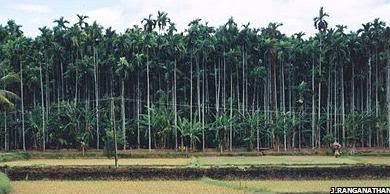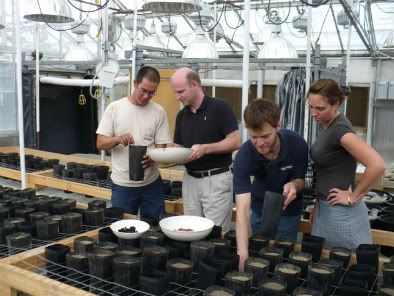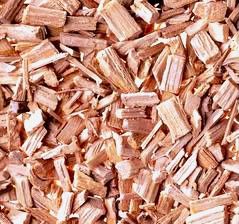Researchers: tropical plantation farms can aid biodiversity

The team of scientists from the US and India chose the site on the coastal fringes of the Western Ghat mountain range because it met a number of attributes the study required:
- a long history of continuous agricultural production
- intense human pressure
- extensive natural areas still remaining
The researchers found a total of 51 forest (bird) species in this study system, they wrote. These species were broadly distributed across the landscape, with 46 (90%) found outside of the intact forest. Within areca nut plantations, they recorded threatened forest species, such as the great hornbill (Buceros bicornis) and the Malabar grey hornbill (Ocyceros griseus).
The team said the combination of the height of the areca nut palms (Areca catechu) and the plantations' close proximity to the intact forest created the necessary ecological conditions to support forest bird species.
They added that data showed the distribution of species in the area had been relatively stable for more than 2,000 years, before the first farmers cultivated the area.
As well as having a high ecological value, the plantations were also economically productive. The areca nut is consumed by about 10% of the world's population, predominantly Asian communities.
The shade provided by the palms' canopy also created the conditions that allowed farmers to grow other high-value crops, such as pepper, vanilla and bananas.
Rather than expanding the plantations, the farmers relied upon the leaf litter from the surrounding production forests to produce mulch for their crops, rather than using costly fertilisers. The researchers also said alternative crops that could be grown in the wet lowlands, such as rice, yielded lower returns both economically and ecologically:
 energy :: sustainability :: biomass :: bioenergy :: biofuels :: tropical :: plantation :: biodiversity :: forest ::
energy :: sustainability :: biomass :: bioenergy :: biofuels :: tropical :: plantation :: biodiversity :: forest :: Lead author Jai Ranganathan, from the US National Center for Ecological Analysis and Synthesis (NCEAS), said the findings provided another option for conservationists to consider
If it is not possible to make places completely protected areas then they can look at whether a system like this will help support the rich biodiversity. [...] It identifies another tool that can be used by conservationists. - Dr Jai RanganathanWhile the production system delivers economic and environmental benefits, health officials have voiced concerns about how the areca nut, which contain a stimulant called arecoline, is primarily consumed.
It is chewed either by itself or as a part of "betel quid", which generally consists of a betel leaf (from the Piper betle vine) wrapped around pieces of areca nut, slaked lime (calcium hydroxide) and generally tobacco.
In 2003, the International Agency for Research on Cancer (IARC) issued a warning that linked chewing areca nuts to an increased risk of cancer.
Dr Ranganathan said the researchers were aware of the health concerns associated with the areca crop, but the purpose of the study was to understand how tropical agriculture and biodiversity could co-exist in close proximity.
Areca nut cultivation has an extremely long history in south and south-east Asia and is likely to continue for the foreseeable future, he said. Given this persistence, I feel that it would be a shame to overlook the potential benefits of this cultivation system for biodiversity.
Dr Ranganathan said that he intended to look for further examples of established agriculture and cultivation practises in the region that provided habitats that supported a high level of biodiversity.
The research indicates that low-impact tropical biofuel plantations can be made equally sustainable, even at the forest frontier, and possibly help millions of the world's poorest.
References:
Jai Ranganathan, R. J. Ranjit Daniels, M. D. Subash Chandran, Paul R. Ehrlich, and Gretchen C. Daily, "Sustaining biodiversity in ancient tropical countryside", PNAS published early edition, November 3, 2008, doi:10.1073/pnas.0808874105
Article continues
 --------------
--------------
 Mongabay, a leading resource for news and perspectives on environmental and conservation issues related to the tropics, has launched Tropical Conservation Science - a new, open access academic e-journal. It will cover a wide variety of scientific and social studies on tropical ecosystems, their biodiversity and the threats posed to them.
Mongabay, a leading resource for news and perspectives on environmental and conservation issues related to the tropics, has launched Tropical Conservation Science - a new, open access academic e-journal. It will cover a wide variety of scientific and social studies on tropical ecosystems, their biodiversity and the threats posed to them.




 In one of the largest renewable energy deals of this year, Drax Group announced an investment of up to £2 billion (€2.5/$3.2bn) into 900 MW of dedicated biomass baseload power, together with Siemens Project Ventures GmbH. This is one of several multi-billion dollar biomass investments announced so far this year, making the bio-power sector the leading renewable energy sector once again. This single investment will supply an estimated 15% of all of the UK's planned renewable power and generate clean energy for 1.3 million British households.
In one of the largest renewable energy deals of this year, Drax Group announced an investment of up to £2 billion (€2.5/$3.2bn) into 900 MW of dedicated biomass baseload power, together with Siemens Project Ventures GmbH. This is one of several multi-billion dollar biomass investments announced so far this year, making the bio-power sector the leading renewable energy sector once again. This single investment will supply an estimated 15% of all of the UK's planned renewable power and generate clean energy for 1.3 million British households.






Thursday, November 06, 2008
Unique rainforest fungus makes bio-hydrocarbons, including diesel from cellulose
The fungus, which has been named Gliocladium roseum, produces a number of different molecules made of hydrogen and carbon that are found in diesel. Because of this, the fuel it produces is called "myco-diesel".
Gliocladium roseum lives inside the Ulmo tree in the Patagonian rainforest. The researchers were trying to discover totally novel fungi in this tree by exposing its tissues to the volatile antibiotics of the fungus Muscodor albus. Quite unexpectedly, G. roseum grew in the presence of these gases when almost all other fungi were killed. It was also making volatile antibiotics. Then when they examined the gas composition of G. roseum, the researchers were totally surprised to learn that it was making a plethora of hydrocarbons and hydrocarbon derivatives. The results were totally unexpected.
Many microbes produce hydrocarbons. Fungi that live in wood seem to make a range of potentially explosive compounds. In the rainforest, G. roseum produces lots of long chain hydrocarbons and other biological molecules. When the researchers grew it in the lab, it produced fuel that is even more similar to the diesel we put in our cars.
When crops are used to make biofuel they have to be processed before they can be turned into useful compounds by microbes, said Professor Strobel. G. roseum however can make myco-diesel directly from cellulose, the main compound found in plants and paper. This means if the fungus was used to make fuel, a step in the production process could be skipped:
The discovery also questions our knowledge of the way fossil fuels are made. The accepted theory is that crude oil, which is used to make diesel, is formed from the remains of dead plants and animals that have been exposed to heat and pressure for millions of years, added Professor Strobel. If fungi like this are producing myco-diesel all over the rainforest, they may have contributed to the formation of fossil fuels.
Picture 1: Colorized environmental scanning electron microscope photo of Gliocladium roseum, an endophtic fungus that produces myco-diesel hydrocarbons. Credit: Gary Strobel.
Picture 2: Culture plate of Gliocladium roseum, an endophtic fungus that produces myco-diesel hydrocarbons. Credit: Gary Strobel.
References:
Gary A. Strobel, Berk Knighton, Katreena Kluck, Yuhao Ren, Tom Livinghouse, Meghan Griffin, Daniel Spakowicz and Joe Sears, "The production of myco-diesel hydrocarbons and their derivatives by the endophytic fungus Gliocladium roseum (NRRL 50072)". Microbiology 154 , 3319-3328; 2008, doi: 10.1099/mic.0.2008/022186-0
Article continues
posted by Biopact team at 10:50 AM 0 comments links to this post
